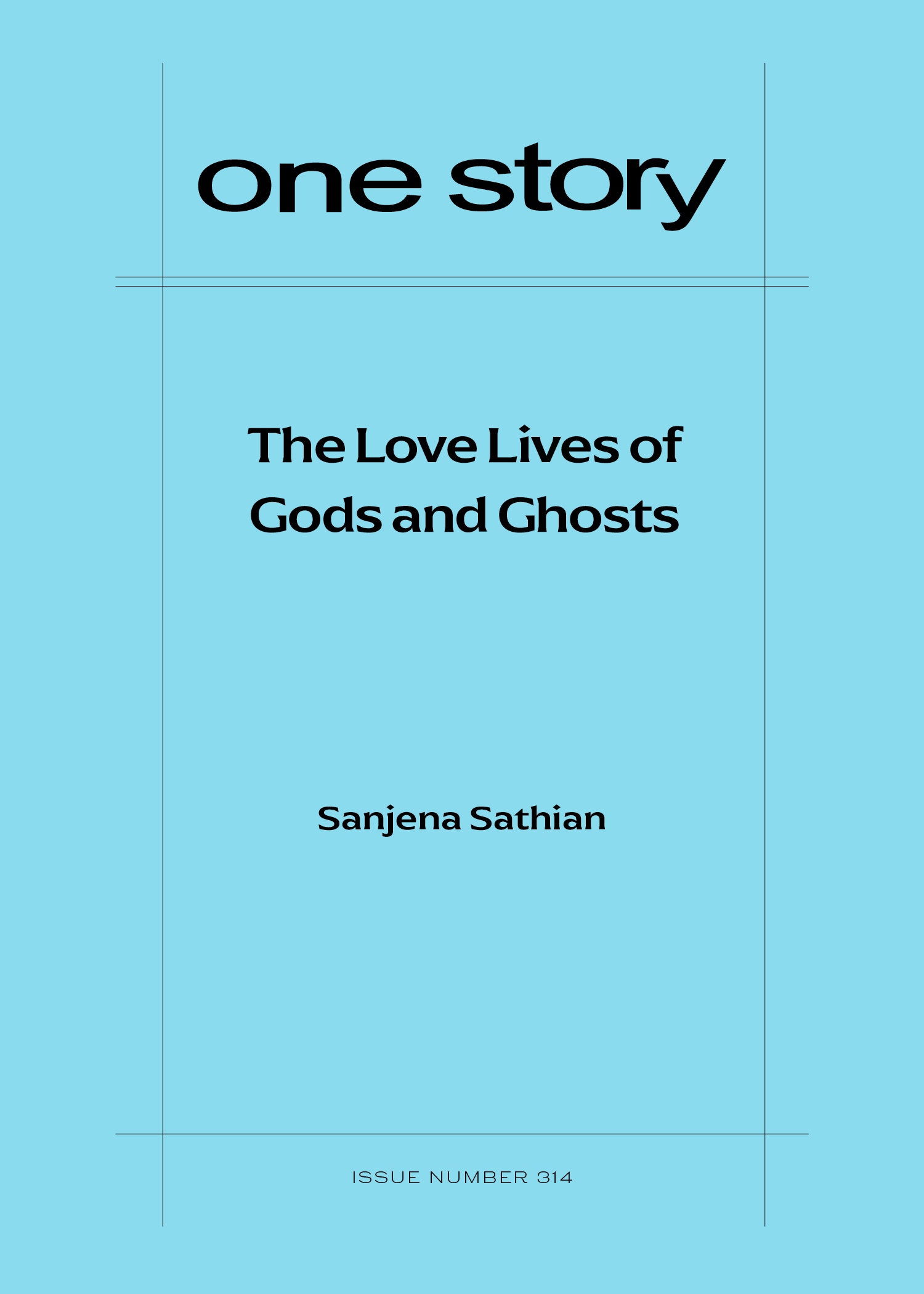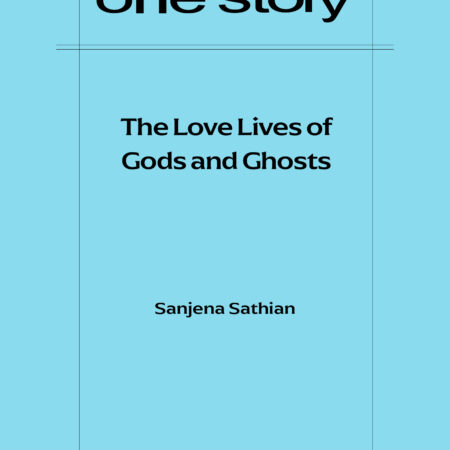
The Love Lives of Gods and Ghosts
$2.50
136 in stock
Excerpt
The leopard had begun to abide by strange hours. The nocturnal creature rose that morning just before sunrise. It lifted from the concrete and its gaze swept the mustard-colored ragi fields. The sharp haunches clenched and loosened as it prowled its new and foreign landscape, the roofless third floor of the unfinished building where it had been sleeping. With one swift paw, it swatted the blue tarp that swung where a wall would eventually be. The leopard sprung. Down from the highest floor to the second story, then again to the dirt. The soil coughed clouds at the impact. The leopard blinked, taking in the end of its old habitat and the start of its new one; to one side of its speckled flank, that hollow-bodied building. To the other: skyscrapers and condominiums in progress, jutting out like jagged teeth from the yellow mouth of the earth. A construction worker squatted in white dhoti and threadbare banyan on the edge of one of the buildings, cleaning his teeth with neem.
The slow-rising orange sun oozed out over the city, dampened a bit by the smog.
“It is so far from home,” came a man’s voice in a queasy whisper.
Sanjena Sathian
Sanjena Sathian is the author of the critically acclaimed novel, Gold Diggers, which was named a Top 10 Best Book of 2021 by the Washington Post and was longlisted for the Center for Fiction’s First Novel Prize. Her short fiction also appears in The Best American Short Stories, the Atlantic, Conjunctions, Boulevard, and more. Her second novel, Goddess Complex, is forthcoming from Penguin Press in March 2025.
Patrick Ryan on “The Love Lives of Gods and Ghosts”
Reshma has been raised in India and has moved to the United States, but she has a lingering and powerful connection to her homeland: her mother, whom she calls Amma. In her ongoing efforts to get Amma moved from her apartment to a new retirement facility that’s being (slowly) built in Bangalore, she returns to check on both the construction and her mother.
“The Love Lives of Gods and Ghosts” is a story that maneuvers the curves of a changing relationship, as Reshma—younger, stronger, and wiser about the contemporary times they live in—discovers that she’s not as equipped as she thought to help and protect Amma, whose world is still very much rooted in the old world. And Amma, it turns out, is not yet ready to reverse roles with her daughter.
When I first read this powerful short story by Sanjena Sathian, I was moved by the undeniable verisimilitude of the grown child/parent dynamic. I was also fascinated by the story’s effective use of a leopard roaming the landscape of the construction site (not because it has wandered into Bangalore, but because Bangalore has expanded into its territory).
“Short fiction lets us glimpse people in the moments before they are about to change—or when they might change but do not,” Sanjena said when I asked her, in our Q&A, why she chose to end the story the way she did. The point of the ending, she says, is to allow the reader to “linger in the dilated moment of change.” I love that answer, because it gets at the heart of why we write short stories, and why we read them: we want to understand the change, why it occurred, why it didn’t, what that means. Sanjena Sathian’s “The Love Lives of Gods and Ghosts” might pull you deep into your reading chair one moment and have you on the edge of your seat the next. We’re delighted to be introducing it to the world.
Q&A by Patrick Ryan
- PR: Where did you get the idea for this story?
- SS: When I was living in India and working as a reporter, I read a news story about a leopard prowling around the edges of Bangalore—the city where half my family comes from. That image stuck with me. I’d grown up visiting Bangalore and hearing stories about it from my mother and grandmother, and I knew how much the place had changed over the past few decades. The city, which had been relatively sleepy for many years, had exploded thanks to the technology industry. Every time I went back, the traffic was more unbearable, the city louder, the air smoggier. And now, the sprawl had gotten so out of control that the city was encroaching into wild places. Because that had to be the explanation: the city had come to the leopard, not the other way around. It really chilled me. So I think the story began just there: with an image that said something about old worlds and new worlds colliding.
- PR: How long did it take you to finish a draft you were happy with?
- SS: I bang out first drafts of short stories relatively quickly—in the span of a few weeks. Usually, these drafts get a few things right—the premise, the setting, the main characters. They’re also mysterious, though. They ask questions of my characters that it will take me months or years to answer. I think that’s how it went with this piece, too. I began with the leopard and then quickly realized I wanted the animal to be lurking in the background of a family story that would also be about old worlds and new worlds, about a first-generation woman returning home to help settle her mother in a senior living community. From there, it took months of picking the piece up and putting it down again to figure out what should happen between the mother and the daughter.
- PR: The story depicts their relationship at a pivotal time in their lives. Can you say a little about the two different directions they’re coming from?
- SS: Reshma, the daughter, grew up in India, but at the time we meet her, she’s living in the U.S. and is married to a white man. She feels like her life in the U.S. is nearly entirely “settled,” except for one thing—her lingering connection to the subcontinent where she came from. She remains emotionally and partially financially responsible for her mother. Reshma’s mother, whom the story just calls “Amma” (mother in Kannada), is recently widowed. In the wake of her husband’s death, she agrees to move into a senior living home. This brings Reshma back to Bangalore to try to sell Amma’s apartment (which Reshma bought). This will in a way divest Reshma from her past, but of course, it also means accepting that Amma is closer to death. The story pushes Reshma to live in the uncomfortable place of knowing that she wants her life to be her own, but that such a desire also seems to involve pushing her mother closer and closer towards death. There’s a dark push-and-pull in these women’s lives, as though neither of them can fully exist while the other one is present.
- PR: I’m not asking for particulars, but do you know what happens in the moments that follow the end of the story? And can you tell us why you chose to end the story when you did?
- SS: The story ended roughly where it ends now when I wrote the first draft, and the ending has always been a point of conversation whenever people have read it. It just felt intuitive to me. Short fiction lets us glimpse people in the moments before they are about to change—or when they might change but do not. I know what happens to these characters right after the story cuts to black, but I also don’t think the reader needs to know. The point is to ask a reader to linger in the dilated moment of change.
- PR: What are you working on now?
- SS: I just wrapped up edits on my second novel, and I’m toggling between projects right now—a new family novel, and a bunch of short stories that are mostly about what I think of as fractured domesticity, and the magical thinking required to sustain relationships and intimacy. I hadn’t worked in the story form for a while, but it seems like I’m picking up some threads from this piece. I think I’m interested in the way our respective life stages sometimes make us incomprehensible to one another.
- PR: What’s the best piece of writing advice you’ve ever received/heard?
- SS: Oh, man. Not blowing smoke up anyone’s you know what, but I genuinely think a lot about what my former professor Sam Chang said at the One Story Debutante Ball in 2017—I wasn’t there, but I read it on LitHub later: “writers, protect your inner life.” She made the point that talking about art publicly has very little to do with what is required to actually make art, and that often we find ourselves reverse engineering explanations to make ourselves sound eloquent. Art-making has much to do with speechlessness and awe. I read that essay over and over again just before my first book came out, and I give it to my students, too.
